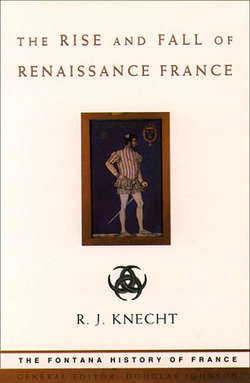Читать книгу The Rise and Fall of Renaissance France - R. Knecht J. - Страница 14
TWO The minority of Charles VIII and the Breton marriage(1483–94)
ОглавлениеWhen Louis XI died on 30 August 1483, his son Charles was only thirteen years old – ten months short of the age of majority for a king of France as laid down by an ordinance of 1374. It was consequently necessary to provide a regent for the intervening period. Four people could claim this role: the queen mother, Charlotte of Savoy; the king’s cousin, Louis duc d’Orléans; and the king’s sister and brother-in-law, Anne and Pierre de Beaujeu. Charlotte could point to the precedent set by Blanche de Castille during the minority of Louis IX, but she was a meek woman who had been allowed only a minor political role by the late king. Orléans was old enough to rule (he was twenty-two years old), but lacked the necessary qualities, being flighty, dissolute and a spendthrift. Anne and Pierre de Beaujeu were better qualified. Anne, who was also twenty-two years old, was intelligent and proud, albeit vindictive and grasping. Her husband Pierre was her senior by twenty-one years and had gained administrative experience under Louis XI. The Beaujeus had important advantages over their rivals: they had custody of the young king and enjoyed the support of the royal civil service; but they could not be sure of the military backing of the great nobles.
Not much is known about the first year of Charles VIII’s reign. Historians have generally assumed that the Beaujeus kept a tenuous hold on the government till the duc d’Orléans fled from the court in 1485. This has been questioned by J. Russell Major, who believes that the Beaujeus were ‘supplanted’ by a council made up of great nobles and their protégés. ‘Supplanted’ seems too strong a word. The Beaujeus retained control while having to co-operate with members of the nobility. Their rival, Louis d’Orléans, became president of the king’s council and lieutenant-general of the Ile-de-France. His uncle, Dunois, was appointed governor of Dauphiné, Valentinois and Diois. Within their orbit were Charles comte d’Angoulême, who was next in line to the throne after Louis, and Jean de Foix, vicomte de Narbonne and comte d’Etampes. Jean duc de Bourbon, elder brother of Pierre de Beaujeu, was showered with favours: he became lieutenant-general of the kingdom, constable of France and governor of Languedoc. Among other prominent nobles who flocked to the court of Charles VIII in 1483 in quest of offices, privileges, gifts and pensions were René II, duc de Lorraine, Alain le Grand, sire d’Albret and Philippe of Savoy, comte de Bresse.
